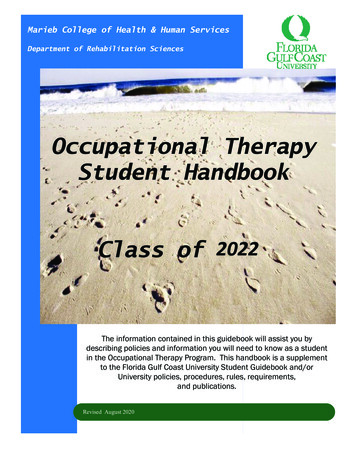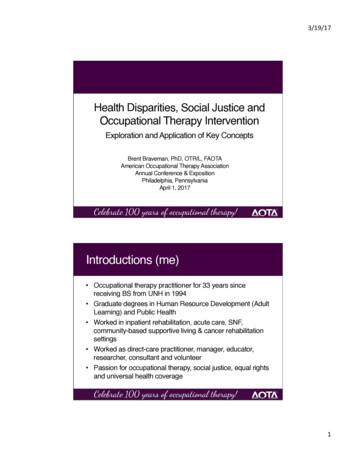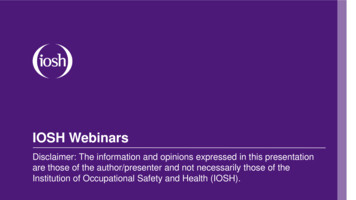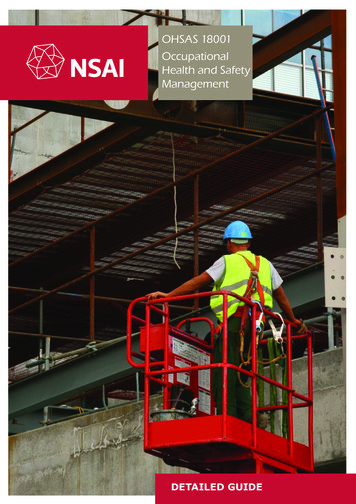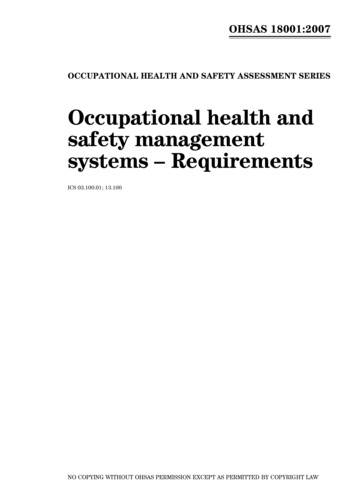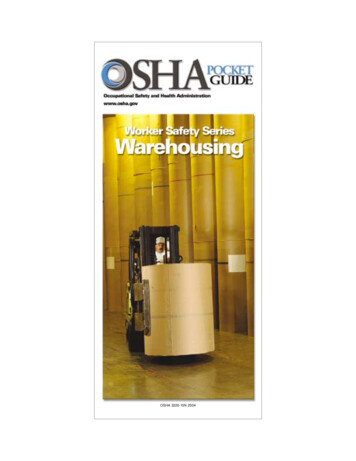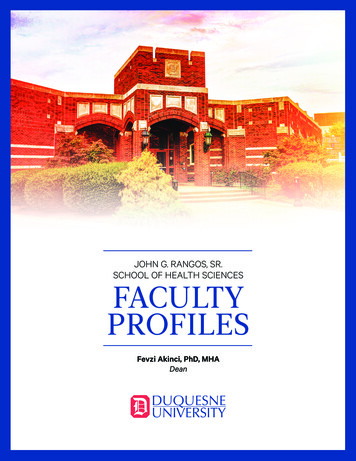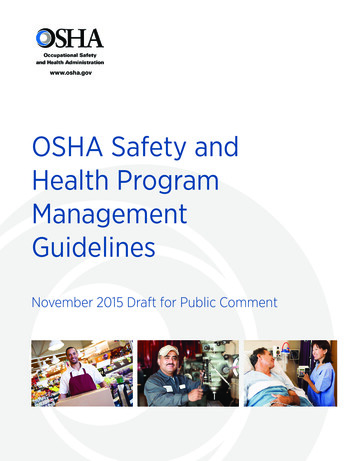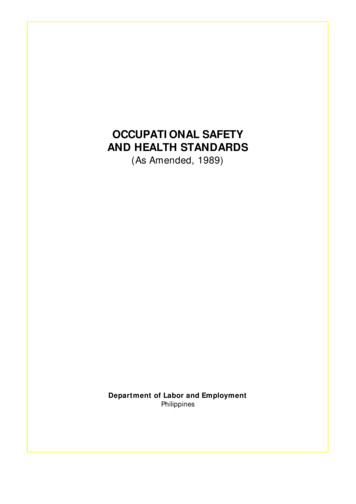
Transcription
OCCUPATIONAL SAFETYAND HEALTH STANDARDS(As Amended, 1989)Department of Labor and EmploymentPhilippines
Reprinted with permissionfrom theBUREAU OF WORKING CONDITIONSDEPARTMENT OF LABOR AND EMPLOYMENTIntramuros, ManilaPublished and printed by theOCCUPATIONAL SAFETY AND HEALTH CENTERDEPARTMENT OF LABOR AND EMPLOYMENTIntramuros, ManilaFebruary 2005-May 2013
FOREWORDThe Occupational Safety and Health Standards was formulated in 1978 incompliance with the constitutional mandate to safeguard the worker’s social andeconomic well-being as well as his physical safety and health. Adopted through thetested democratic machinery of tripartism, the 1978 Standards is considered as alandmark in Philippine labor and social legislation.The advent of industrialization and the continuing introduction oftechnological innovations in our country today have, however, correspondinglyincreased the number and types of occupational hazards that our workers areexposed to. Viewed against this backdrop, it became imperative that the Standardsbe revised to make it truly responsive to the workers’ needs.Joint efforts exerted by the Bureau of Working Conditions, the ILOManila Office and the tripartite sectors bore fruit in August 1989 when the revisionswere finally approved by the Secretary of Labor and Employment pursuant to hisauthority under Article 162 of the Labor Code of the Philippines. With the latestimprovements in the Standards, all establishments covered will now be providedwith a better tool for promoting and maintaining a safe and conducive workingenvironment.I therefore urge all sectors concerned-whether they be in labor, management,government or the academe-to extend their full support to achieve the nobleobjectives of the Occupational Safety and Health Standards.RUBEN D. TORRESSecretary03 July 1990
TABLE OF CONTENTSRULE 1000 GENERAL sAdministration and EnforcementSpecial lnspection, Investigation and ReviewDuties of Employers, Workers and Other PersonsConfidentiality of Trade Secrets112334RULE 1010 OTHER SAFETY RULES101110121013Promulgation of RulesSpecial RulesHazardous Workplaces557RULE 1020 REGISTRATION1021102210231024General ProvisionRegistrable UnitPeriod of RegistrationRegistration8888RULE 1030 TRAINING OF PERSONNEL INOCCUPATIONAL SAFETY AND HEALTH1031103210331034.011034.02Training ProgramsAccreditationTraining and Personnel ComplementQualifications of a Safety ConsultantProhibition in the Practice of Occupational Safety and Health9991010RULE 1040 HEALTH AND SAFETY COMMITTEE10411042104310441045104610471048General RequirementsTypes and Composition of Health and Safety CommitteeDuties of the Health and Safety CommitteeTerm of Office of MembersDuties of EmployersDuties of WorkersDuties of the Safety ManOther Types of Safety Organizations1111121313131414RULE 1050 NOTIFICATION AND KEEPING OF RECORDSOF ACCIDENTS AND/OROCCUPATIONAL l ProvisionReport RequirementsKeeping of RecordsEvaluation of DisabilityMeasurement of Performance151616171719i
RULE 1060 PREMISES OF 0681069General ProvisionsConstruction and MaintenanceSpace RequirementWalkway SurfaceFloor and Wall OpeningStairsWindow OpeningsFixed LaddersOverhead Walks, Runways and PlatformsYards21212122222325252626RULE 1070 OCUPATIONAL HEALTH ANDENVIRONMENTAL CONTROL1071107210731074107510761077General ProvisionsThreshold Limit Values for Airborne ContaminantsThreshold Limit Values for Airborne Contaminants (Tables)Physical AgentsIlluminationGeneral VentilationWorking Environment Measurement28282929303233RULE 1080 PERSONAL PROTECTIVE EQUIPMENTAND DEVICES1081108210831084108510861087General ProvisionEye and Face ProtectionRespiratory ProtectionHead ProtectionHand and Arm ProtectionSafety Belts. Life Lines and Safety NetsUse of Safety Shoes34343536373738RULE 1090 HAZARDOUS eneral RulesHot and Corrosive SubstancesStorageUse of Lead and Its Compounds393939434446RULE 1100 GAS AND ELECTRICWELDING AND CUTTING OPERATIONS1100.01 General Provisions1100.02 Personal Protective Equipment1100.03 Welding or Cutting in Confined Spaces474747RULE 1120 HAZARDOUS WORK PROCESSES1121Underground Tank and Similar Confined Space Workii48
RULE 1140 EXPLOSIVES1141114211431144114511461147General ty and Distance TablesStorage of ExplosivesRecords of Disposition of Explosives49495050505157RULE 1150 MATERIALS HANDLING AND STORAGE1150.01 General Provisions60RULE 1160 eneral ProvisionsPower BoilersHeating BoilersCleaning and RepairsPersonal Protective EquipmentColor CodingRequirement in the Preparation of Boiler Pressure Vessels Plans6161636971747474RULE 1170 UNFIRED PRESSURE Steam Heated Pressure VesselsClosed Steam Heated Pressure VesselsOpen Steam Heated Pressure VesselsWater and Air Pressure TanksRefrigeration TanksCompressorValves7781818586888990RULE 1180 INTERNAL COMBUSTION 1Internal Combustion Engine Room/Building92Requirements in the Preparation of Internal Combustion Engine Installation Plan 94Portable/Mobile Internal Combustion Engine96RULE 1200 MACHINE visions of GuardsStandard Machine GuardsMachine Guard at Point of OperationTransmission Machinery GuardingWoodworking MachineryGuarding Mechanical Power Presses and Foot and Hand Power Pressesiii979798101101104106
RULE 1210 ELECTRICAL SAFETY1211121212131214Philippine Electric CodeElectrical Safety Inspection,Inspection FeesRequirements in the Preparation of Electrical Plans108108110110RULE 1220 ELEVATORS AND RELATED EQUIPMENT12211222122312241225DefinitionsGeneral ProvisionsGeneral RequirementsStandards RequirementsRequirements in the Preparation of Plans112113114118119RULE 1230 IDENTIFICATION OF PIPING 30.07ScopeStandard RequirementsDefinitionsMethods of Identification of Contents of Piping SystemsVisibilityLocation of Stenciled or Lettered LegendsType and Size of Letters for Stencils121121121121121122122RULE 1240 POWER PIPING LINES124112421243124412451246DefinitionsGeneral ProvisionsStandards RequirementsConstructionNon-Destructive TestHydrostatic Test123123123123124124RULE 1410 CONSTRUCTION onsGeneral ProvisionsExcavationScaffoldingsConstruction EquipmentPlant and EquipmentDemolitionMechanical E 1420 LOGGING14211422142314241425142614271428General ProvisionsHandtoolsGeneral Logging OperationsUse and Maintenance of Power SawsLogging EngineLogging Engine OperationTractor YardingLines, Blocks, Rigging141141141142143143145146iv
RULE 1940 FIRE PROTECTION AND CONTROL19411942194319441945194619471948General ProvisionsDefinitionsBuilding Construction and FacilitiesFire Fighting FacilitiesFlammable and Combustible LiquidsCombustible SolidsElectrical InstallationAlarm Systems and Fire Drills147147147149151153157157RULE 1950 PESTICIDES AND sGeneral ProvisionsPesticidesFertilizersDisposal of Unwanted Materials163163164164165168RULE 1960 OCCUPATIONAL HEALTH SERVICES1961196219631964196519661967General ProvisionsHazardous WorkplaceEmergency Health ServicesTraining and QualificationsDuties of EmployersOccupational Health ProgramPhysical Examination169171171174175177178RULE 1970 FEES1971197219731974General ProvisionsExplosivesLocal Fabrication of Boilers/Pressure VesselsCertificates of Safety Practitioner/Consultants182182182183RULE 1980 AUTHORITY OF LOCAL GOVERNMENT198119821983198419851986General ProvisionsAuthority to Chartered CitiesAuthority of MunicipalitiesAuthority of Other Government AgenciesApplication of this Standard of Existing Plans and AuthoritiesDuplication of Inspection184184186186186186RULE 1990 FINAL PROVISION199119921993199419951996False Statement or RepresentationSeparabilityResolution of Conflicts and Overlapping JurisdictionsRepeal of Prior Safety Orders 1995 Penal ProvisionsPenal ProvisionsEffectivityv187187187187187187
ANNEXESDepartment Order No. 20Table 3.1 Materials for “U” GuardsTable II Standard Colors of Signs for Safety Instructions & Warnings inBuilding PremisesTable 6 Tabulation of Scheduled ChargesTable 8 Threshold Limit Values for Airborne Contaminants188190190Table 47Table for Medicines, Medical Supplies & Facilities207Fig. 10Symbols of Category of Hazards212IP-3Application for Registration214IP-5Report on Health and Safety Organization215IP-6Employer’s Work Accident / Illness Report216IP-6aGovernment Safety Engineer’s Accident Investigation Report218IP-6bAnnual Work Accident / Illness Exposure Data Report21947-AAnnual Medical Report Form220ISD-T4Application for Boiler226ISD-T5Application for Internal Combustion Engine Installation227ISD-T6Application to Install Elevator / Manlift / Dumbwaiter228ISD-6AApplication to Construct Hoistway and Install Gates or Doors230ISD-T9Application for Boiler / Unfired Pressure Vessel Fabrication232Application for Electrical Wiring Installation233192193Forms--Department Order No. 13 - Guidelines Governing OSH in the Construction Industry234Memorandum Circular No. 02, Series of 1998 - Technical Guidelines for ClassifyingHazardous and Non-Hazardous Establishments, Workplaces andWork Processes246Memorandum Circular No. 01, Series of 2000 - Implementing Guidelines for theConduct of Workplace Environment Assessment (WEA) inHazardous Establishments and Work Processes250Guidelines in Accomplishing Supplemental Form IF No.5(Workplace Environment Assessment Data)253Memorandum Circular No. 02, Series of 2000 - Guidelines in the Application ofthe Workplace Component of Republic Act No. 8504 otherwiseknown as the “Philippines AIDS Prevention and Control Act of 1998”and its Implementing Rules and Regulations259Department Order No. 16-01 - Series of 2001- Rule 1030 Training and Accreditationof Personnel on Occupational Safety and Health262Department Order No. 57-04 - Series of 2004 - Guidelines on the EffectiveImplementation of Labor Standards Enforcement271Department Order No. 38-03 - Series of 2002 - Creating an Inter-Agency Committeeon STD / HIV and AIDS in the Workplace274vi
Department Order No. 44-03 - Series of 2003 - Commemoration of April 28 asWorld Day for Safety and Health at Work276Department Order No. 53-03 - Series of 2003 - Guidelines for the Implementation ofa Drug-Free Workplace Policies and Programs for the Private Sector277Department Order No. 37-03 - Series of 2002 - Creating a Task Force for aDrug-Free Workplace281Annex 2 Guidelines for the Implementation of a Drug-Free WorkplacePolicies and Programs283Department Order No. 73-05 - Series of 2005 - Guidelines for the Implementation ofPolicy and Program on Tuberculosis (TB) Prevention and Controlin the Workplace285Department Order No. 74-05 - Series of 2005 - Rule 1162.02 of Rule 1160 onBoiler of the Occupational Safety and Health Standards292Department Circular No. 1 - Series of 2008 - Policy Guidelines Governing the295Occupational Safety and Health of Workers in the Call Center IndustryDepartment Circular No. 2 - Series of 2008 - Amending Certain Provisions of theOccupational Safety and Health Standards298Joint DTI-DENR-DA-DOF-DOH-DILG-DOLE-DOTC Administrative Order No. 01299Series of 2008 - The Adoption and Implementation of the GloballyHarmonized System of Classification and Labeling of Chemicals (GHS)Department Circular No. 1 - Series of 2009 - Guidelines on Occupational Safety andHealth in the Shipbuilding, Ship Repair and Shipbreaking Industry313Department Order No. 102-10 - Series of 2010 - Guidelines for the Implementation ofHIV and AIDS Prevention and Control in the Workplace Program319Department Advisory No. 05 - Series of 2010 - Guidelines for the Implementation of aWorkplace Policy and Program on Hepatitis B324vii
OCCUPATIONAL SAFETY AND HEALTH STANDARDSBy virtue of the powers vested in the Department of Labor and Employment under Article162 of the Labor Code of the Philippines, this Occupational Safety and Health Standards is herebypromulgated for the guidance and compliance of all concerned. This body of standards rules andregulations shall hereafter be referred to as “Standards”RULE 1000GENERAL PROVISION1001:Purpose and Scope:(1)The objective of this issuance is to protect every workingman against the dangers ofinjury, sickness or death through safe and healthful working conditions, thereby assuringthe conservation of valuable manpower resources and the prevention of loss or damage tolives and properties, consistent with national development goals and with the State’scommitment for the total development of every worker as a complete human being.(2)This Standards shall apply to all places of employment except as otherwise provided in thisStandard.1002:Definitions:For purposes of this Standards and except as otherwise indicated, the following shall mean:(1)“Employer” includes any person acting directly or indirectly in the interest of an employer,in relation to an employee, and shall include government-owned or controlled corporationsand institutions, as well as non-profit private institutions or organizations.(2)“Employee” shall mean any person hired, permitted or suffered to work by an employer.(3)“Industrial Enterprise” shall mean any workplace, permanent or temporary, including anybuilding or collection of buildings, shed, structure, yard or any other place, wherepermanently or temporarily one or more persons are employed in any manufacturing ofgoods or products processing and any other activity similar and incidental thereto.(4)“Agricultural Enterprise” shall include forestry and logging operations, farming in all itsbranches, and among other things, includes cultivation and tillage of the soil, dairying, theproduction, cultivation, growing and harvesting of any agricultural and horticulturalcommodities, the raising of livestock and poultry, and any practice performed by a farmeron a farm as an incident to or in conjunction with such farming operations, but does notinclude the manufacturing or processing of sugar, coconut, abaca , tobacco, pineapple orother farm products.(5)“Dry Dock” shall include premises where work is performed on shore or on board ships inwhich ships or vessels are constructed, repaired, refitted, finished or broken up and housed.(6)“Health” shall connote a sound state of the body and mind of the worker, which enableshim to perform his job normally, in a state of well-being.(7)“Safe or Safety” shall refer to the physical or environmental conditions of work or employment,which substantially comply with the provisions of this Standards.(8)“Work Accident” shall mean an unplanned or unexpected occurrence that may or may notresult in personal injury, property damage, work stoppage or interference or any combinationthereof, which arises out of and in the course of employment.(9)“Work Injury” shall mean any injury or occupational illness suffered by a person, whicharises out of or in the course of his employment.GENERAL PROVISIONS1
(10) ”Occupational Illness” shall mean any illness caused by environmental factors, the exposureto which is characterized or peculiar to a particular process, trade or occupation and towhich an employee or worker is not ordinarily subjected to or exposed outside of or awayfrom such employment.(11) ”Recognized Hazards” are those which do not require technical or testing devices to detect.(12) ”Workplace” means the office, premises or work site, where the workers are habituallyemployed and shall include the office or place where the workers, who have no fixed ordefinite work site, regularly report for assignment in the course of their employment.(13) ”Approved” shall mean acceptable to the Secretary in writing after proper examinationshowing compliance with prescribed Standards.(14) “Code” shall mean the Labor Code P.D. 442 as amended.(15) “Department” shall mean the Department of Labor and Employment.(16) “Secretary” shall mean the Secretary of Labor and Employment.(17) “Bureau” shall mean the Bureau of Working Conditions.(18) ”Director” shall mean the Director of the Bureau of Working Conditions.(19) ”Standards” shall mean the Occupational Safety and Health Standards.(20) ”Enforcement officer” shall mean the industrial safety engineer, the labor regulation officer,or any duly authorized representatives of the Secretary to enforce this Standards.(21) ”Authorized Representative” shall mean and include chartered cities, municipalities,employees or officials of other government agencies empowered by the Secretary of Laborand Employment to enforce the provisions of this Standards.1003:1003.01 :2Administration and Enforcement:Department of Labor and Employment:(1)The Department of Labor and Employment shall administer and enforce the provisions ofthis Standards.(2)Every employer shall give to the Secretary or his duly authorized representative access toits premises and records for the purpose of determining compliance with the provisions ofthis Standards.(3)Every establishment or place of employment shall be inspected at least once a year todetermine compliance with the provisions of this Standards. Special inspection visits,however, may be authorized by the Regional Labor Office or as authorized under Rule 1980of this Standards, to investigate accidents, occupational illnesses or dangerous occurrences,especially those resulting in permanent total disability or death, to conduct surveys ofworking conditions requested by the Bureau for the purpose of evaluating and assessingenvironmental contaminants and physical conditions or to conduct investigations, inspectionsor follow-up inspections upon request of an employer, worker or a labor union of theestablishment.(4)The enforcement officer shall determine reasonable periods of compliance with recommendationsdepending on the gravity of the hazards needing corrections or the period needed to comeinto compliance with the order.RULE 1000
1003.02:Application to Other Places of EmploymentWhen a condition of employment in workplaces not specifically covered by this Standards is thesubject of complaints, the provision of this Standards shall apply.1003.03:Application to Transportation:Establishments engaged in land, sea and air transportation are not covered except their garages,dry docks, port hangars, maintenance and repair shops.1003.04:Application to Mines:The activities of a lessee regarding safety of mining installations, surface or underground, withinthe mining claim or lease, including mine safety, mineral conservation and problem of pollution inestablishments or workplaces falling under “Mining Industry” as classified by the National Economicand Development Authority are not covered by this Standards.1003.05:Application to Chartered Cities and Municipalities:The Department of Labor and Employment shall be solely responsible for the administration andenforcement of this Standards in all places of employment except as provided in Rule 1980 of thisStandards.1004:Special Inspection, Investigation and Review:(1)Any worker or representative of workers or any concerned person who believes that aviolation of any provision of this Standards threatens physical harm or imposes imminentdanger to life, may request an inspection by giving full particulars or details regarding suchviolation or danger to the Regional Labor Office or duly authorized representative. If uponappraisal of such notification, the Regional Office or its duly authorized representativefinds reasonable ground to believe that a violation has really been committed or dangerexists, a special inspection or investigation shall be conducted immediately. The complainantshall be notified in writing of the outcome of such investigation or inspection, immediatelyupon its completion.(2)The Secretary of Labor and Employment on his own initiative or on complaints of theworkers, shall review any failure or refusal of the Regional Labor Office or duly authorizedrepresentative to order compliance or issue recommendation with respect to such complaintor reported violation.1005(1):Duties of Employers, Workers and other Persons:Each employer covered by the provisions of this Standards shall:a.furnish his workers a place of employment free from hazardous conditions thatare causing or are likely to cause death, illness or physical harm to his workers;b.give complete job safety instructions to all his workers, especially to those enteringthe job for the first time, including those relating to the familiarization with theirwork environment, hazards to which the workers are exposed to and steps takenin case of emergency;c.comply with the requirements of this Standards; andd.use only approved devices and equipment in his workplace.GENERAL PROVISIONS3
(2)Every worker shall cooperate with the employer in carrying out the provisions of thisStandards. He shall report to his supervisor any work hazard that may be discovered inhis workplace.(3)Every worker shall make proper use of all safeguards and safety devices furnished inaccordance with the provisions of this Standards for his protection and that of others, andshall follow all instructions given by the employer in compliance with the provisions of thisStandards.(4)It shall be the duty of any person, including any builder or contractor or enforcementagent, who visits, builds, renovates, or installs devices, or conducts business in anyestablishment or workplace, to comply with the provisions of this Standards and allregulations of the employer issued there under as well as with other subsequent issuancesof the Secretary.1006:Confidentiality of Trade Secrets:All information reported to or otherwise obtained by the enforcement officer in connection with anyinspection or proceedings under this Standards, which contains or might reveal a trade secret, shallbe considered confidential except that such information may be revealed in any proceeding whereit is required or necessary. The Secretary, the Regional Director or duly authorized representative,shall issue appropriate orders to protect the confidentiality of trade secrets.4RULE 1000
RULE 1010OTHER SAFETY RULES1011:Promulgation of Rules:Safety and health rules may be promulgated, amended, modified, or revoked in the followingmanner:(1)The Bureau, on the basis of information submitted in writing by interested parties or onthe basis of information available to it, upon determination that a Rule should be promulgatedor amended in order to serve the objectives of the Code, shall draft a proposed Rule.Conformably with the principle of tripartism, the Bureau may ask the advice and assistanceof individuals and organizations, private or public agencies, particularly recognized workers’and employers’ organizations, having special knowledge of the proposal under consideration.(2)The Bureau shall prepare the proposal taking into consideration suggestions and recommendationsavailable.(3)The Director shall forward the proposal to the Secretary for approval. The Secretary shallwithin thirty (30) days from receipt thereof act on the proposal. If rejected, same shall bereturned to the Bureau with his reasons. After a reconsideration of the returned proposal,the Director shall resubmit his proposal in the manner herein outlined.(4)After approval of the proposal by the Secretary, the same shall be published in a newspaperof general circulation and shall take effect fifteen (15) days from the date of publicationand shall become part of this Standards.1012:1012.01:Special Rules:Work Conditions or Practices Not Covered by Standards:Any specific rule applicable to a condition, practice, means, methods, operations or processes shallalso apply to other similar work situations for which no specific rule has been established.1012.02:Abatement of Imminent Danger:(1)An imminent danger is a condition or practice that could reasonably be expected to causedeath or serious physical harm before abatement under the enforcement procedures canbe accomplished.(2)When an enforcement officer finds that an imminent danger exists in a workplace, he shallinform the affected employer and workers of the danger and shall recommend to theRegional Director the issuance of an Order for stoppage of operation or other appropriateaction for the abatement of the danger. Pending the issuance of the Order the employershall take appropriate measures to protect the workers.(3)Upon receipt of such recommendation, the Regional Director shall immediately determinewhether the danger exists and is of such a nature as to warrant the issuance of a StoppageOrder or other appropriate action to minimize the danger.(4)The Order shall require specific measures that are necessary to avoid, correct or removesuch imminent danger and to prohibit the presence of any worker in such location wheresuch danger exists, except those whose presence are necessary to avoid, correct or removesuch danger or to maintain a continuous process or operation. Where stoppage of operationis ordered, the Order shall allow such correction, removal or avoidance of danger onlywhere the same can be accomplished in a safe and orderly manner.OTHER SAFETY RULES5
(5)Immediately after the issuance of a Stoppage Order, the Regional Director shall furnish theSecretary, through the Director, within forty-eight (48) hours a copy of the Order and allpertinent papers relating thereto, together with a detailed description of the work conditionssought to be corrected, the safety and health rule violated by the employer, and thecorrective measures imposed. The Secretary shall review the Order issued by the RegionalDirector and within a period of not more than five (5) working days, issue a final Ordereither lifting or sustaining the Order of the Regional Director.(6)The Order shall remain in effect until danger is removed or corrected.1012.03(1)(2)6:Suspension of Rules:The Secretary may issue to an employer-applicant a temporary order suspending theeffectivity date of a Rule or any part of this Standards for the following reasons:a.the unavailability of professional or technical personnel or of materials andequipment needed to comply with the rule;b.necessary construction or alteration of the prescribed facilities cannot be completedon the effectivity date of the rule;c.the employer is participating in experiments or studies approved or conducted bythe Bureau designed to demonstrate new techniques to safeguard the safety andhealth of workers.In such a case, the employer-applicant shall establish:a.the reason why he is applying for a suspension order, specifying the rule or portionhe seeks suspension of;b.that he is taking all available and necessary steps to safeguard his workers againstthe hazards covered by the rule, and that he is prescribing necessary measures,methods, operations and practices which he must adopt and use while thesuspension is in effect;c.that he has an effective program for coming into compliance with the rule asquickly as possible, specifying a given date for compliance;d.that he has informed his workers of the application and a copy of the applicationand reasons thereof have been given to the workers or their duly authorizedrepresentative.(3)The application shall be submitted to the Regional Director or duly authorized representative,as the case may be, who after hearing the workers or their duly authorized representativeshall evaluate and recommend action to the Secretary, through the Director. He may issuean interim order to be effective until the suspension order is issued by the Secretary.(4)The suspension order, including the interim order, shall prescribe the practices, means,methods, operations, or processes which the employer must use and adopt while the orderis in effect and while the program for coming into compliance with the rule is beingimplemented.(5)The suspension order shall not be in effect longer than the period needed by the employerto come into compliance with the rule, or one year, whichever is shorter, renewable foranother year, subject to revocation or shortening of the period by the Secretary, if such iswarranted.RULE 1010
1012.04:Variation Order:(1)If there shall be practical difficulty or unnecessary hardship in complying withthe requirements of any rule or provision of this Standards, the Secretary, upon therecommendation of the Director, may issue an order allowing a variation in complying withsuch requirements, provided that the purpose of such rule or provision is substantiallyserved and the safety and health of the workers remain ensured. The employer affected bysuch rule or provision may request in writing the Secretary, thru the Regional Labor Office,to authorize such a variation stating the grounds for the request and the measures to betaken or already being taken.(2)An application for a variation shall contain:(3)1013a.a specification of the rule or provision or portion thereof from which the employeris seeking a variation.b.an attestation from technically qualified person that the employer is unable tocomply with the rule and detailed reasons thereof;c.a detailed statement of the measure he will take or is already taking to protectthe workers against the hazards covered by the rule or provision; andd.a certification that the workers have been informed and a copy of the applicationhas been furnished the workers or their duly authorized representative.A variation order shall stipulate the conditions under which the variation is permitted andshall be applicable and effective only to the particular employer and operations covered bythe Order. A variation order shall remain in effect until revoked by the Secretary.:Hazardous Workplaces:For purposes of this Standards, the
RULE 1210 ELECTRICAL SAFETY 1211 Philippine Electric Code 108 1212 Electrical Safety Inspection, 108 1213 Inspection Fees 110 . Annex 2 Guidelines for the Implementation of a Drug-Free Workplace 283 Policies and Programs Department Order No. 73-05 - Seri

